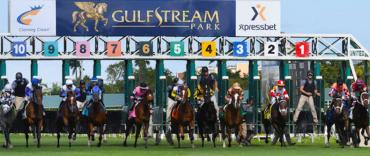
Horse racing fatalities this year at Santa Anita’s fabled Southern California track have put the Sport of Kings under the scrutiny of politicians, animal rights activists, the media, and the thoroughbred racing industry itself.
Thirty horses died in racing or training since Christmas at Santa Anita. As if the unusually high number wasn’t cause for consternation, a freak accident at Del Mar racetrack to the south on the second day of its summer meet brought more headlines. A racehorse broke loose during early morning training, collided with another and both died.
California politicians, prodded by adverse national publicity, public outcry, and -- let’s face it -- political gain, sprung into action. Government oversight over thoroughbred track operations was tightened. Additionally, the Stronach Group, owners of Santa Anita, detailed protocols addressing the safety issue.
For every 1,000 thoroughbred racing starts in 2018, there were 1.68 equine deaths, according to the Jockey Club’s Equine Injury Database. That figure is down 16 percent from 2008 when statistics were first measured but up slightly from the three previous years.
Here’s the real problem: the number is anywhere from two and a half to five times greater than the fatality rate in Europe and Asia, where rules against performance-enhancing drugs are enforced more stringently.
Amid the controversy, Florida thoroughbred racing has remained relatively unscathed, possibly because equine performers here haven't got an inordinate number of serious injuries or deaths. Tampa Bay Downs, which opened in 1926, is the oldest track in the state. Gulfstream Park and Casino in Hallandale Beach attracts the nation’s best jockeys, trainers, and horses during its winter meet. Gulfstream is also owned by the Stronach Group.
After Kentucky, the Ocala area is the pride of the thoroughbred breeding industry. With the state having the third-highest equine population in the country, there’s no doubt that the industry is a major agribusiness for Florida.
Florida has not suffered the number of thoroughbred fatalities at its tracks that the other big racing states have. And the Sunshine State has plenty of reason to do things right.
At stake here is a sport with a $6.8 billion impact, according to an American Horse Council study released last year. And the sport is growing in Florida, not contracting as some overzealous opponents tend to fabricate. That nearly $7 billion figure represents a 33 percent gain over the results of a study 10 years earlier.
The Florida horse racing industry directly supports more than 12,000 people statewide with those workers receiving more than $400 million in wages and benefits each year. The jobs include those engaged in the care, feeding, training and transportation of horses; those engaged in racetrack operations serving the horses, horsemen and visitors and maintaining the pari-mutuel wagering industry.
There is no parallel between the thoroughbred racing industry and greyhound racing, which the public overwhelmingly (61 percent) voted to abolish last November. Greyhounds lived in a crate 22 hours a day and, as fast as they may be, are not born to run a la Springsteen.
Before they chase artificial lures, greyhounds are taught to chase and kill live rabbits. The state’s remaining 11 greyhound tracks must be shuttered by 2021, according to terms of the referendum.
“The greyhound racing industry is being outlawed because it was incapable of reform, and out of touch with American values about animal welfare,” said Christine A. Dorchak, president and general counsel of Greyhound 2K Worldwide, an organization leading a crusade to ban dog racing everywhere.. “Rather than welcome fundamental change, dog racers attacked critics and covered up problems.”
Unlike their tone-deaf counterparts in the greyhound industry, thoroughbred leaders have been responsive. Amid growing complaints in March, the Stronach Group, for instance, made changes to its drug and veterinary policies that would match international standards.
The Stronach Group declared that Santa Anita horses will race with no race-day medication with the exception of the diuretic Lasix, which will still be permitted, but at a maximum of 50 percent of the previous levels. All horses born in or after 2018 will race at Santa Anita and Golden Gate (another California track owned by Stronach) will do so with no race day medication, including Lasix. This means all 2-year-old horses starting in 2020 and after will be racing medication free.
Florida horsemen oppose proposals to curb Lasix, used to prevent Exercise Induced Pulmonary Hemorrhaging (EIPH), i.e. horses bleeding from their lungs while running. But one can safely bet the Stronach family, not wanting a repeat of the excruciating California experience, is reassessing rules at Gulfstream as well as other tracks it owns in Maryland and Kentucky.
Jim Bleyer, a former reporter at the Orlando Sentinel and Tampa Tribune, writes the Tampa Bay Beat blog.


